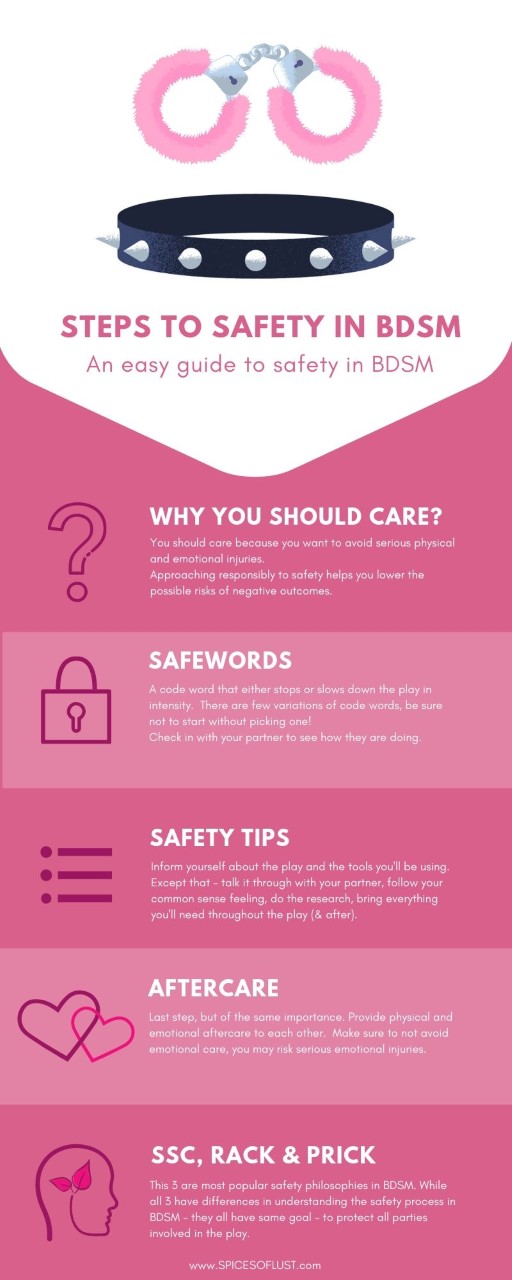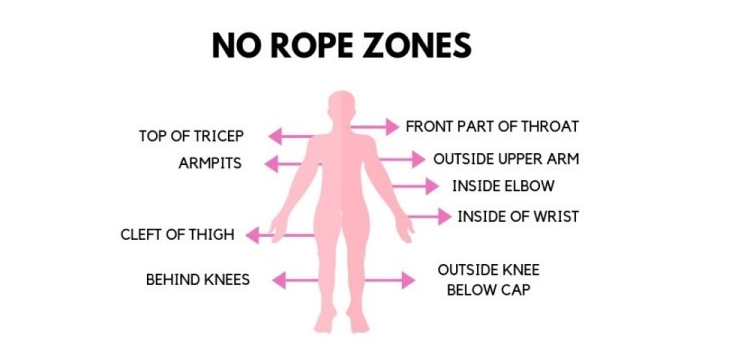 WHY BEING SAFE IS IMPORTANT
WHY BEING SAFE IS IMPORTANT
When it comes to BDSM safety is of utmost importance. Not only does it help you maintain the physical aspects, it also protects the emotional health of everyone involved.
While the relationship you have with your partner(s) is not relevant (new partner, long-time partner, friend with benefits, etc), safety & aftercare should be taken seriously with all of them. Situations can get very intense and we can get carried away easily (one of the reasons people do it). In those moments injuries can occur, physical and/or emotional. Not to mention that emotional damage can leave scars that are hard to get past and heal.
So, not to jeopardize your health, relationship, or fun, it’s best to insist on safety and conversation.
PHYSICAL & EMOTIONAL SAFETY
Any time you decide to engage in BDSM it’s best to get to know the type of play you plan on participating in. All of the involved parties have to know the ins and outs of the activity so they can make a decide if it’s something they want to engage in. Not only that, but it also gives them a good idea of what to expect, how to play safely, and
BDSM communities developed three philosophies regarding safety. They are different individually, but in the end, safety is the prime concern of all three.
- SSC – Safe, Sane & Consensual
- RACK – Risk-aware, Consensual Kink,
- PRICK – Personal responsibility, consensual kink.
We discussed the differences in our article Safety in BDSM – RACK, SSC, and PRICK..
Each of these philsophies promote consent as tremendously important. Essentially, it is what differentiates BDSM from abuse. You have to be well informed about all the possible risks you are taking, be aware of all physical injuries that may happen, and where they may happen. Also, you have to be informed and aware that emotional damage can occur. Point being, if you are not informed enough, you can’t properly consent.
SAFEWORDS
A ‘safeword’ is a code word used by a person to indicate almost crossing or crossing boundaries. Boundaries can be physical, moral, mental, or emotional. They are often common words like red, stop, etc. But can be any word of your choosing. Sometimes, if agreed upon, certain safe words don’t stop the play, just tone it down if it’s too harsh or rough.
Boundaries or limits are set before play, through a communication or through contracts.
The limits can be:
- No limit
- Hard limit
- Soft limit
- Requirement limit
- Time limit
Hot Tip!
During the play, check in with your partner to see how they are doing. You are more likely to avoid crossing any limits by doing regular check-ins.
SAFETY TIPS
There are several general tips regarding safety:
- Do the necessary research if you are doing something for the first time. Start with Google and continue if you think you are not prepared enough
- Talk it through. It might help you anticipate possible problems.
- Use common sense. When something just doesn’t feel right – it probably is not.
- Bring/ prepare everything you’ll need throughout the play and after (care).
Along with general safety tips, there are many more suggestions about the actual thing you’ll be doing and ‘’tools’’ you’ll be using.
For example, there are many tips and tricks about bondage. From the type of rope to pressure points and no rope zones. We encourage you to read The Simple Bondage Guide, in case you’ll be practicing bondage, it’s easy to digest and you might learn a few new things.
No rope zones are indicated on the following graphic

Another example is temperature play like playing with candles and wax. Again, it’s highy advised that you inform yourself and your partner about what to expect and how to play safely. Jumping into it can lead to buying the completely wrong type of candle and ultimately, lead to serious skin injuries. Not only that, there are many tips and tricks out there. I personally didn’t know (or even think about it before) – it is a smart move to shave the area where you plan on pouring wax.
AFTERCARE
Aftercare may come last in the story of safety in BDSM but it’s equally important. As an act, aftercare has to be a part of any BDSM play or lifestyle, it’s not optional nor it is an addition. It breaks down into two types of aftercare. First one is physical while the second one emotional.
Physical aftercare is important if there are any bruises, injuries, scratches left after the play. Every dominant (top, master) should offer and give medical help to his submissive (bottom).
Steps to do:
- clean the bruised/ injured area,
- apply the cream to the area so the skin recovers faster,
- bring some ice to reduce the pain,
- use Band-Aids if necessary.
Injured areas should be a priority after the play. Don’t forget to bring some water and food. BDSM sessions can be long lasting and exhausting. The body needs both food and water to recover.
In addition to things said, a proper dominant has to also provide emotional aftercare to their submissive. Sessions can be rough. For starters, your language can be rough and rude. And, depending on what you do, your submissive may endure pain while it lasts and after. All of that can cause emotional detachment from you and cause emotional injuries. It’s for these reasons that emotional aftercare is an absolute must.
Steps to do:
- hug,
- kiss,
- cuddle
- spend some quality time together
- talk about what happened and exchange your experiences
- offre reassurance
- provide ‘security’ for your submissive
- make them feel loved
Safety and aftercare should be taken very seriously. Whether you are deeply involved in BDSM community and your plays are hardcore, or you are a beginner and you are trying out some vanilla things.
It will help prevent possible negative outcomes, make both sides happier, and should you advance with your play – it will allow you to be prepared. Always ensure your relationship (no matter the type) doesn’t suffer by not taking safety and aftercare with a sense of responsibility.

























